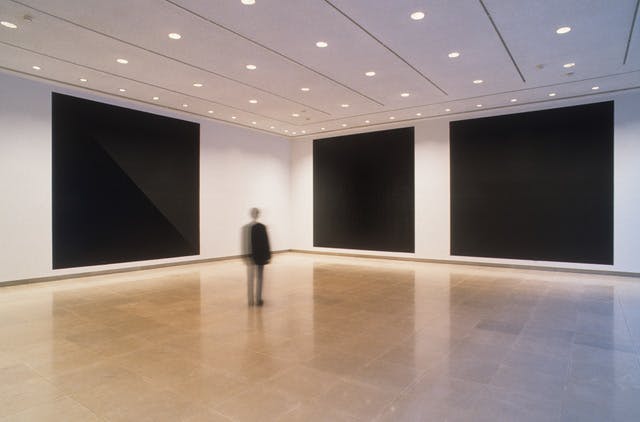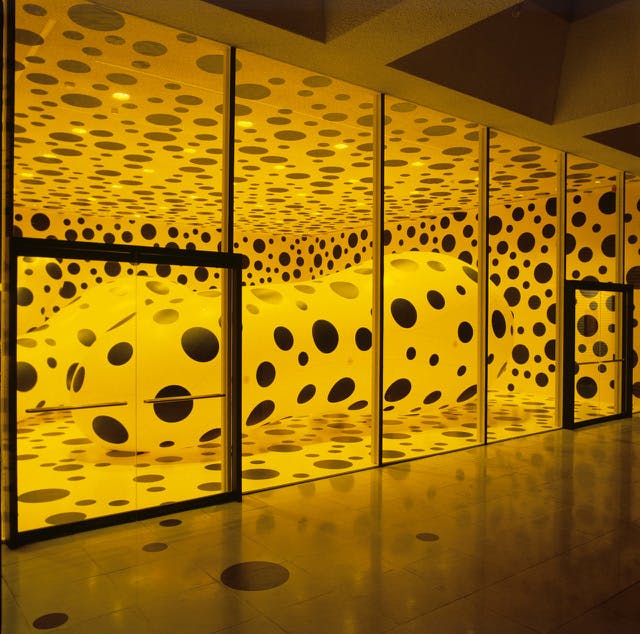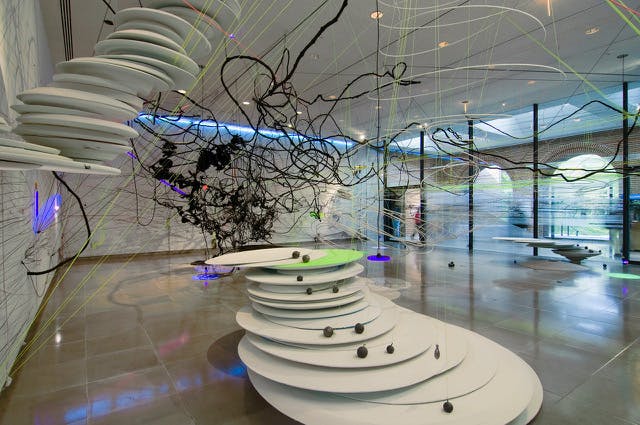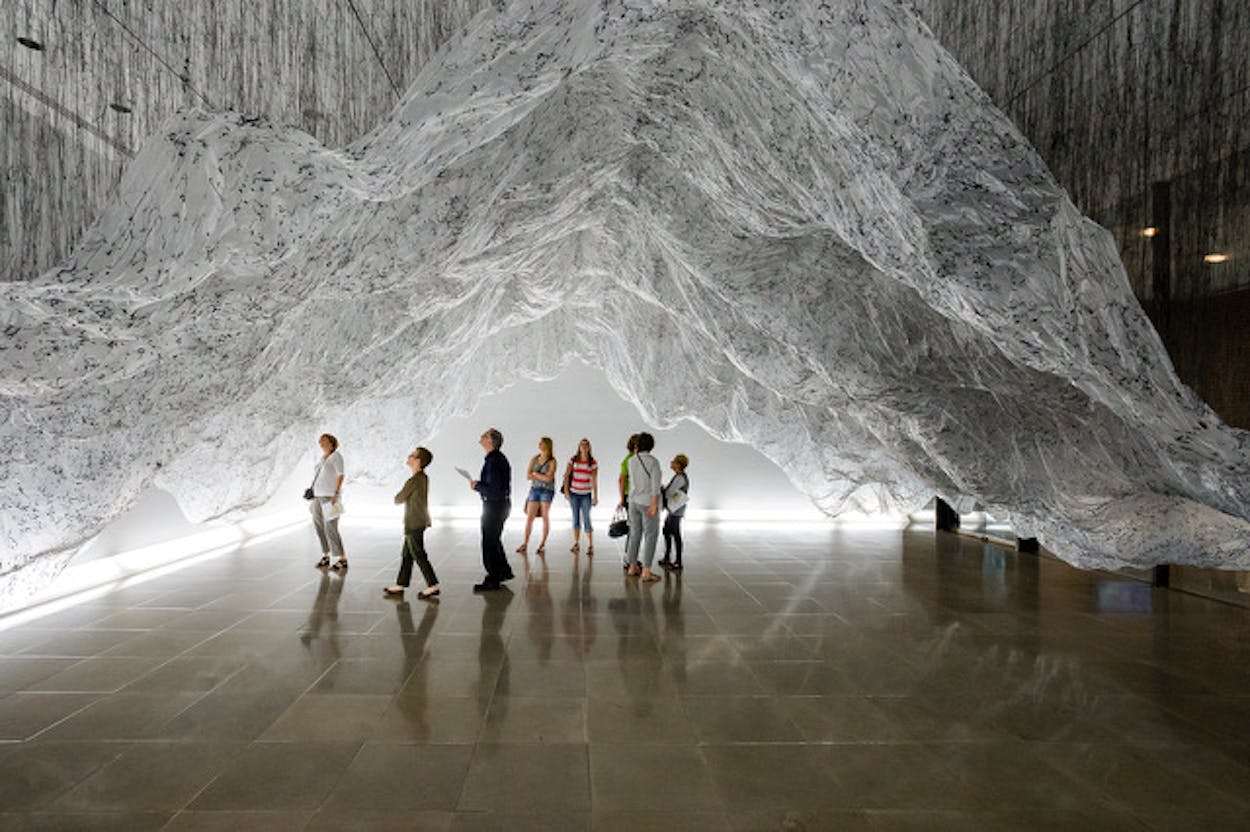For more than twenty years, Rice University has offered a one-of-a-kind opportunity for artists to think big. Rice Gallery, located at the entrance to campus, in the front of Sewall Hall, is the only university gallery used exclusively for site-specific installation art—in other words, art that is conceived of and constructed at a particular place for the purpose of somehow transforming or responding to that space. The artists are not only creators but also craftsmen, often expending a large amount of sweat equity.
Rice Gallery has successfully procured artists to create large-scale art that conforms to its 40-foot-by-44-foot space featuring a 16-foot ceiling and a glass-walled entrance, where pieces can be illuminated on display at night. The artists who have been invited to exhibit there are giants in their field, including Judy Pfaff, a 2004 MacArthur genius fellow; Yayoi Kusama, Japan’s greatest living contemporary artist; and Sol LeWitt, the minimalist and conceptualist New York visionary whose Glossy and Flat Black Squares—number 813 in his Wall Drawing series—debuted at the gallery in 1997.
This particular work of LeWitt’s consists of black paintings that on the surface are staid but are meant to demonstrate the principles of art reduced to their purest form. Those familiar with the Houston art scene would likely compare them to Mark Rothko’s black paintings at the Rothko Chapel. There is no direct correlation, but both pieces—voids to be filled by the imagination—insist on contemplation from their viewer. Kimberly Davenport, the director of Rice Gallery, remembers when LeWitt’s piece was first on display and Dominique de Menil, who with her husband, John, founded the Rothko Chapel, paid a visit with her daughter.

“She asked for a chair and she sat alone in the gallery for more than half an hour, just in the presence of this work,” Davenport says. “Obviously, she found this to be very profound and significant.”
From February 9 through May 14, Glossy and Flat Black Squares will be reinstalled in Rice Gallery to commemorate the work’s twentieth anniversary. According to Davenport, this is probably the last time it will be shown. For one thing, the LeWitt Collection owns it, and if some place wanted to put it on display again, a room of these exact proportions would essentially have to be built. Also, once this exhibition is over, Rice Gallery—the space the piece was expressly made for—is closing and will be converted into a welcome center for the university.
This is a bittersweet moment for Davenport, who became the director of the gallery in 1994. After the gallery closes in May she will move over to the campus’s new interdisciplinary Moody Center for the Arts in a curatorial role. Davenport was recruited from the Wadsworth Atheneum Museum of Art, in Hartford, Connecticut, the country’s oldest public art museum, where she was the associate curator of contemporary art. An intern from the museum who went on to get his Master of Fine Arts at Rice alerted her to the upcoming position at the gallery.
Davenport was tasked with breathing new life into the gallery, operated previously by a rotating cast of figures in the university’s art and art history department. At the time, the Rice campus was considered insular. The gallery was intended to attract people from outside the university. Davenport promptly changed the name from Sewall Gallery to Rice University Art Gallery, or Rice Gallery, and recognizing the good bones of the place, turned the focus to site-specific installation art.
“You have to really look for these artists, because there aren’t many who are doing or are interested in focusing primarily on scale, in large scale,” Davenport says. “And scale is the most dominant feature here. It isn’t just a matter of taking something little and making it big. It really is a whole different set of mechanics. I have to see the work in person, because what might look really great in a picture can be highly disappointing in person, or vice versa.”
She scored the breakthrough LeWitt commission in 1997 because of her previous experience working with a LeWitt collection on loan at the Wadsworth Atheneum. Since then, she has hosted more than sixty shows at Rice Gallery. Davenport started with a shoestring budget but was eventually able to secure enough funding to provide each and every artist—whether it was an emerging one, or a famous one who wanted the freedom to create without concern for market value—with roughly $50,000 to do his or her work, including everything from transportation to materials to per diem.
All of the installations have been learning experiences for the staff—and no two have been the same. Certain artists created on the cheap, yet cleverly, like the Japanese artist Yasuaki Onishi, whose reverse of volume RG (2012) used simple plastic drop cloths, black hot-glue, steel wire, and a mound of cardboard boxes. Other artists worked themselves to the brink, like the Korean-born, New Hampshire–based artist Soo Sunny Park, whose Unwoven Light (2013) consists of heavy chain-link fence bent and shaped and then embellished with hundreds, if not more than a thousand hand-sanded cutouts that were hand-wired into the fencing.

For the gallery’s 1997 show Dots Obsession, by the Japanese artist Yayoi Kusama, a partnering agency helped to bridge the language gap. Correspondence between gallery and artist was done via facsimile machine. “She sent the materials over, and then we faxed her what the gallery looked like, and she faxed us back how it should be installed,” Davenport says.

For the 1999 exhibition The History of the World, by London-based Rice alumnus Michael Petry, the gallery had to source seven tons of sand to be fashioned into a video screen onto which Petry projected images. “So you had the thing of bringing in the seven tons of sand and getting it formed,” Davenport says. “But then, even more of a challenge was getting the sand out. It had increased in weight, taking on water from the atmosphere.
And for . . . . . all of the above, by the New York–based artist Judy Pfaff, the gallery staff more or less just got out of the way. Pfaff brought her own materials and assistants and immediately began drawing on the walls, realizing her installation upon entering the gallery space. “She actually spent part of her childhood in Texas, and what she remembered was the changeability of the weather,” Davenport says. “She talked a little bit about that, in terms of some of the action going on in her installation.”

Given the illustrious history and rarified position of Rice Gallery, why in the world is it being closed? According to Alison Weaver, the executive director of the Moody Center for the Arts, this should be seen as a kind of relocation and not a closure. The installation art that Rice Gallery is known for will not completely disappear. When the $30 million Moody Center opens, on February 24, it will aim to carry on this tradition.
“We’re not ending a good thing,” Weaver says, “but enhancing it by giving it a dynamic new home.”
Rice Gallery, February 9 to May 14, ricegallery.org
Other Events Across Texas
DALLAS
Right of Way
The Dallas Museum of Art has so much art that it is giving some of it away. Before purchasing a ticket and exploring the building’s interior galleries for culturally relevant exhibitions like Daumier’s Political and Social Satire and Shaken, Stirred, Styled: The Art of the Cocktail, experience some complimentary art in the Concourse Gallery, where on display through this weekend only is Pathway, a mural by the Swiss artist Nicolas Party that immerses viewers in wild environs for free.
Dallas Museum of Art, February 3–5, dma.org
FORT WORTH
Bullish on Texas
As a young man, country-rock musician Ryan Bingham moved to Stephenville, near Fort Worth, to pursue bull-riding at a rodeo school only to find that his interests lay in writing songs. When Bingham, now a resident of Los Angeles, returns to Cowtown for gigs Friday and Saturday at Billy Bob’s, he’ll show a lot of love for Texas, considering that he’s touring in support of an album titled Ryan Bingham Live: Recorded Live in Texas 060816.
Billy Bob’s Texas, February 3 & 4, 10:30 p.m., binghammusic.com
HOUSTON / AUSTIN
Welcome to Ellis Island
Rolling Stone declared Texas singer-songwriter Robert Ellis’s recent self-titled album—a cool mix of Americana, pop, and country—one of 2016’s best, and NPR gave the song “California” a similar distinction. Those accolades have helped earn Ellis a coveted spot at Super Bowl Live at Discovery Green on Friday. If that sounds a little too overwhelming, it might be more to your liking to catch him Saturday in the relaxed environment of the Paramount, in Austin.
Discovery Green, February 3, 6:15 p.m. & Stateside at the Paramount, February 4, 8 p.m., robertellismusic.com
SAN ANTONIO
Wishing Well
Confucius was a politically correct, ancient Chinese philosopher who promoted moral freedom, social etiquette, and doing that which was just and honorable. Embrace these tenets of positivity on Saturday at the San Antonio River Walk during the event Confucius Wishing Lanterns on the Water, in which the public sets lanterns lit with a floating LED candle into the water as a symbolic gesture of their hopes and dreams becoming a reality.
River Walk, February 4, 5 p.m., thesanantonioriverwalk.com
SAN ANTONIO
Holy Mozart
The music of Mozart will on Sunday return to a familiar sort of place for the composer: the Roman Catholic Church. Two hundred and sixty-one years after Mozart was baptized at the Salzburg Cathedral, in Salzburg, Austria, works of his including Serenade No. 12 for Winds and the opera The Marriage of Figaro will be performed at the San Fernando Cathedral, in San Antonio, as part of the San Antonio Symphony Mozart Festival.
San Fernando Cathedral, February 5, 7 p.m., sasymphony.org
- More About:
- San Antonio
- Houston
- Fort Worth
- Dallas
- Austin






